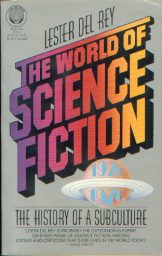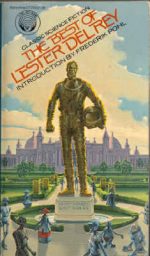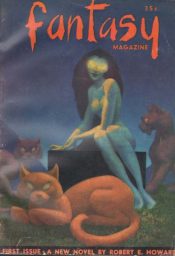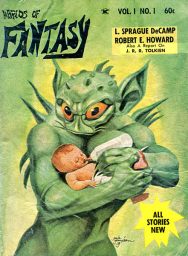The Atomic Age Narrative: The History of a Subculture
Sunday , 26, March 2017 Uncategorized 17 Comments For the past few weeks, I have highlighted opinions masquerading as criticism that are at best highly suspect from the view of 2017.
For the past few weeks, I have highlighted opinions masquerading as criticism that are at best highly suspect from the view of 2017.
One history of science fiction and fantastic fiction in general that is a joy to read is Lester del Rey’s The World of Science Fiction (Del Rey, 1979).
Lester del Rey (born Leonard Knapp, 1915-1993) was part of the Campbellian stable of writers from 1938 to about 1950. Del Rey is different from what you think of Campbellian fiction. The science was not exactly hard. The stories often had an emotional aspect missing from science fiction of this period.
I had read one of del Rey’s juvenile’s, Tunnel Through Time, a Scholastic Book Service book back in fourth or fifth grade. In the summer of 1983, I was reading just about anything I could get my hands on from our small (but rather good) library in North East, PA. I was branching out from Lovecraft and Howard and venturing into classic science fiction. The library had The Best of Fritz Leiber, The Best of Henry Kuttner, and The Early del Rey.
There were stories that I liked: “The Faithful,” “Shadows of Empire,” “Dark Mission,” “The Years Draw Nigh.” I did not like everything by Lester del Rey but there were stories that I liked enough to remember to this day.
Del Rey edited some magazines along the way– Fantasy Magazine, Rocket Stories, Science Fiction Adventures (first title), Space Science Fiction, and  Worlds of Fantasy. In 1975, he was brought in to edit the fantasy line for Ballantine Books. His wife, Judy Lynn del Rey, had been brought in to edit the science fiction line in 1973, first as an assistant and then as editor in 1975.
Worlds of Fantasy. In 1975, he was brought in to edit the fantasy line for Ballantine Books. His wife, Judy Lynn del Rey, had been brought in to edit the science fiction line in 1973, first as an assistant and then as editor in 1975.
The World of Science Fiction: 1926-1976 The History of a Subculture was published in November 1979. Interesting that the book came out almost at the perceived dividing line of 1980.
Dely Rey covers science fiction in six sections starting with The Odyssey and Lucian of Samosata up to Star Wars.
I had forgotten how good a history of science fiction this book is. Del Rey has a commonsense attitude to things backed up with sales numbers.
He prefers strong plot over style. There is no contempt for any period of fiction. The only movement he does not like is the British “New Wave” movement of the 1960s viewing it as a over artistic failure.
He takes John W. Campbell to the woodshed for his psi mania of the early 1950s. He makes the case that the science fiction magazine “ghetto” was critical for the genre.
“The most important aspect of the first period the science fiction was the rapidity of its evolution…This rapid evolution could not have occurred without the appearance of the specialized magazines. To those who bewail the past ‘ghettoization’ of science fiction, I suggest that the present general acceptance of the literature would have been impossible without such a past.”
He has a rejoinder to Damon Knight and James Blish:
“ ‘Art’ was also becoming a matter of concern among some of the writers–but they were interested in what they conceived as the art of science fiction writing. They were apparently ashamed of the old pulp tradition of the field and wanted science fiction to be treated as a serious art form. Most of the early advocates of this avowed art were not among the highly successful writers, though Damon Knight and James Blish were leaders in the movement. Perhaps the reason for this concern with art among many of the less successful writers lies in the fact that more far more writers can handle style well than can plot skillfully–and editors tend to favor good plots. Somehow, style is usually believed to be akin to art, while plotting is considered only a mechanical skill. And, naturally, every man considers his own product to be the right and proper one. The topic led to many long and serious discussions.”
Del Rey divides science fiction into The Age of Wonder (1926-1937), The Golden Age (1938-1949), The Age of Acceptance (1950-1961), The Age of Rebellion (1962-1973).
He devotes a chapter to the economics of science fiction in the 1950s including distribution and how many good titles the market will bear. He made a good point that I never thought of. Science fiction magazines appeared to be doing better in comparison to other fiction magazine genres in the 1950s for two reasons- T.V. was not doing science fiction in the 1950s and neither were mass market paperback publishers.

There is a chapter devoted to fantasy. Del Rey categorizes fantasy as epic fantasy, heroic fantasy/sword-and-sorcery, weird, whimsy, and fantastic conceit. What is fantastic conceit you say?
“This is a type of story which really has no honest fantasy element at all. It depends on something fantastic being or happening–something that is clearly out of the ordinary, but does not involve magic or the supernatural. . . Often these stories are much admired by editors who don’t like real fantasy, and too frequently they are ‘too beautiful to print.’ They also tend to contain ‘wonderful’ philosophical bits, usually banal.”
An interesting comment on Tolkien’s paperback success:
“Did that mean fantasy sold? No, indeed. Booksellers solved that by making a new ruling: Fantasy didn’t sell; Tolkien sold.”
He had hard but accurate words about the Ballantine Adult Fantasy line:
“It seemed a good idea. By publishing such works, there could be no question about the quality of the line. But it did not quite work. The most ardent fantasy lovers admired the books–but too often already had copies. Many others found the style too often unnatural in its affectations, or the stories old-fashioned. Again, I suspect that the covers were not right; many were beautiful–as art–but they didn’t reflect the nature of the books. The sales were meager, on the average, and the line was abandoned.”
Lester del Rey included economic factors though out this book which helps to explains failures and successes. He gives a good overview of fiction from 1926 to the early 1970s.
There is no finger wagging at pulp era fiction whether from the scientific romance, gadget story of the late 1920s, 1930s space opera, H. P. Lovecraft, Robert E. Howard, and Weird Tales. Del Rey takes a very tolerant attitude and embraces diverse forms of science fiction and fantasy. His one criterion is competent execution of the story. Del Rey did not like academics telling them to “keep out of my ghetto.”
Lester knew what he was doing. Del Rey’s fantasy line dominated in the late 1970s through the 1980s.
This is a really-good book if you know little of the history of science fiction before 1980 and want to learn more. I also recommend James Gunn’s Alternate Worlds.

I’ve generally liked what I’ve read from Del Rey, both his fiction and commentary/editorial stuff.
Del Rey and Gunn were both Merritt fans, BTW. It seems to be a fairly accurate metric for those authors and editors back in the post-pulp period. The ones who weren’t were often dicks and detriments to the field.
This is positively refreshing after the stuff you’ve reviewed before in this section.
I’ve just checked and, while there is no Kindle edition available at this point, this book can be borrowed from Internet Archive
https://archive.org/details/worldofsciencefi00delr
-
Also, lots of second-hand copies on Amazon (and, presumably, other online booksellers) at reasonable prices.
Del-Rey used to be a reliable go-to in the bookstores. Then, gradually, they stopped becoming so reliable. Then I stopped buying their books altogether, after one too many disappointments.
-
You could use that comment for all major SF&F publishers except Baen.
-
The Del Rey imprint DID publish the Robert E. Howard volumes in the mid/late 2000s, for which they deserve some credit, but that was an anomaly.
http://howardworks.com/ballantine-delrey.html
-
Those were the reprints of Wandering Star’s earlier, much prized limited editions, classy illustrations included. That explains while they were such an anomaly for latter years Del Rey: they didn’t originate with them.
-
Yeah.
Del Rey tried to create something similar for Moorcock, on their own, and it was far shoddier production. I still have no idea what criterion they used while selecting stories for those, not to mention that they kept changing illustrators and styles of illustration. They’re still OK, but they are vastly inferior to REH editions.-
The covers of the Moorcock reprints are hilariously busy and the lettering is ugly. Nowhere near as elegant as the REH reprints.
-
-
It was my understanding that Moorcock was consulted right down the line. That’s why there are so many “edited” stories in there. MM loves to revise and diddle with his work. Still, Del Rey was once again publishing more honest-to-Arioch S&S in the 21st century, which was somewhat surprising.
-
-
Del Rey still published them, not some other house. Not all of them were “reprints.”
Look, I’m not saying that Del Rey was the Second Coming of great publishing, just that they weren’t simply reprinting all of the WS volumes. They took the template and ran with it, for which they should be proud. Publishing what was basically historical adventure — in the cases of EL BORAK and THE SWORD WOMAN — for an SFF line took some guts.
The Wandering Star Catalog:
http://howardworks.com/wanderingstar.html
-
I’m aware that they expanded on Wandering Star’s original catalogue, and yes, making it widely accessible and affordable, and expanding on it while keeping the original idea and high level of quality, is something worthy of highest praise.
I was merely answering to that “anomaly” bit.
-
-
What madness is this?! It is as if he actually loved the genre and had no agenda in mind!
I’ll be checking this out (though, dislike of BAF covers makes me sad).
Every time you write one of these, I have to go back to my own history of SF and break out the eraser.
Thanks, though. You’ve given me a couple of new angles to pursue.
This is, for once, remarkably aligned with this blog’s position. I quite like his division of SF’s eras too, Age of Wonder is as perfect a name for pre-Campbell pulp SF (and not just SF) as you can get. I do wonder how he’d name what came after The Age of Rebellion, heh.
The Age of Estrogen